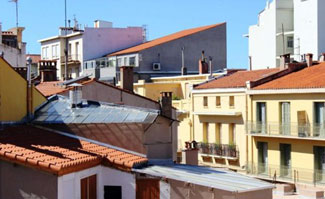My Great Expectations

Coming to France, I expected there to be an abundance of wines. I expected to stuff my face with carbohydrates. I expected to fail to meet the standards of French haute couture. I even expected to be surrounded by a constant cloud of second-hand smoke. Perpignan has certainly met all of those expectations. From my daily morning croissants to my newfound delight in evening apéritifs, this southern city has provided me with a great deal of insight into the French culture. But for all I imagined, I never anticipated the palpable Spanish influence that exists here in Perpignan.
When I visualized France, I suppose I had stereotypes on the brain. The classical romanticism of Paris, the vivid lavenders of Provence and the everlasting vineyards of Burgundy were what my inexperienced Canadian mind had envisioned. Instead, in Perpignan I found myself surrounded by brightly colored stuccoed buildings, haphazardly tiled orange roofs and intricate wrought-iron metalwork. Less than an hour from Spain's border, Perpignan has historical roots that are clearly visible within the town's architectural style. The blend of French and Spanish culture has shaped this border city into a uniquely designed region, unlike many of its neighboring French towns.

Only half an hour away, Céret, buried in the valley at the base of the Pyrenees, exudes a rural French feel with its quaint little homes, cobblestone roads and rolling hillsides. Even the touristy city of Montpellier, despite being packed with travelers speaking a variety of languages, possesses the structural style and romantic ambiance typically associated with French culture. But Perpignan seems to be straddling the line between its Spanish neighbors to the west and French family to the north, giving the city a commanding Mediterranean flavor.
It wasn't until I came across the term "Catalan" that it all finally began to come together. I had first noticed the presence of a third language at the Barcelona airport, under the Spanish and English words for "bathroom." And the Catalan community, divided by the border between France and Spain, has become increasingly intriguing to me with each passing day in Perpignan. In a nation with such obvious cultural tendencies, this little section of France stood out as an exception to the rule. The Catalan culture, which has now mostly shifted into the Spanish borders, continues to tangibly thrive throughout Perpignan. From the rugby team to the souvenir shop, at the turn of every corner in this southern French city, you're sure to find a representation of the Catalan people.
It was Vincent Dumas, founder of the Catalan web magazine La Clau, who suggested to our class that "the only thing that Spanish and French Catalans have in common is their language and their history." But the more I explore Perpignan, the more I've found that I disagree. From the Pyrenees Mountains to the Mediterranean Sea, the existence of the Catalan community lives on in France through the common architectural influence that unites Perpignan to its Catalan ancestors, for as far as the eye can see.
Recent Posts
The Cloth of the Sun by Su Kim
The Sculptor and his Wife by Mary Barczak
The Language Barrier by Jim Cameron
The Sixth Sense: Understanding by Christina Cocca
Bastille Day Bees by Annie Petersen
Reaching New Heights by Sarah Raghubir
Vive Perpignan by Chelsea Boone
The Changing Collioure Art Scene by Ariana Bacle
Having a Boule with Pétanque by Kristin O'Brien
Corridas in the 21st Century by Victoria King
Controversy Fermenting? by Marika Washchyshyn
A Different Culinary Landscape by Simon Arseneau
Student Pages
Simon Arseneau
Ariana Bacle
Mary Barczak
Chelsea Boone
Jim Cameron
Christina Cocca
Justine Dhollande
Su Kim
Victoria King
Kristin O'Brien
Annie Petersen
Sarah Raghubir
Alexis Sanchez
Maegan Simmons
Marika Washchyshyn
About the Program
Fifteen college students came from North America to Perpignan, France, in June 2011 to produce these videos and stories. To find out more, read a welcome letter from program director Rachele Kanigel, meet the program faculty and explore the 2010 website.

